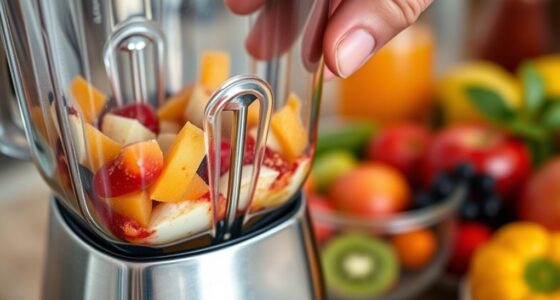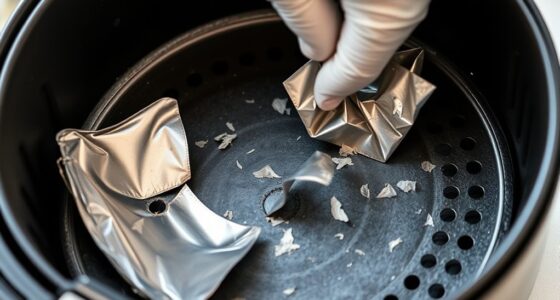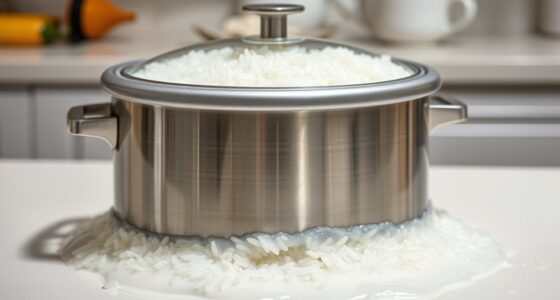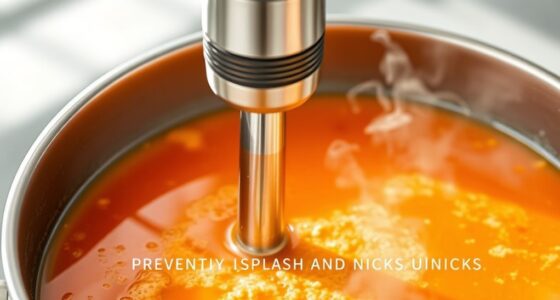To prevent a burn message on your pressure cooker, make certain you always use enough liquid—usually at least 1 to 1.5 cups—and avoid overfilling. Properly prepare and layer your ingredients, keeping starchy foods, thick sauces, or purees away from direct heat contact. Regularly clean and check the pressure release valve and gasket to prevent buildup. Managing these factors will help you avoid scorching and cook safely every time—discover more tips to perfect your pressure cooking.
Key Takeaways
- Ensure sufficient liquid (at least 1-1.5 cups) and avoid filling the cooker more than two-thirds full.
- Rinse ingredients thoroughly and layer them properly to prevent sticking and burning.
- Regularly clean the pressure release valve and gasket to maintain proper pressure and avoid false burn alerts.
- Use appropriate pressure settings and cooking times, adjusting for altitude to prevent overheating and scorching.
- Opt for natural or quick release methods as recommended, and monitor pressure buildup to reduce burn messages.
Understanding the Causes of the Burn Message
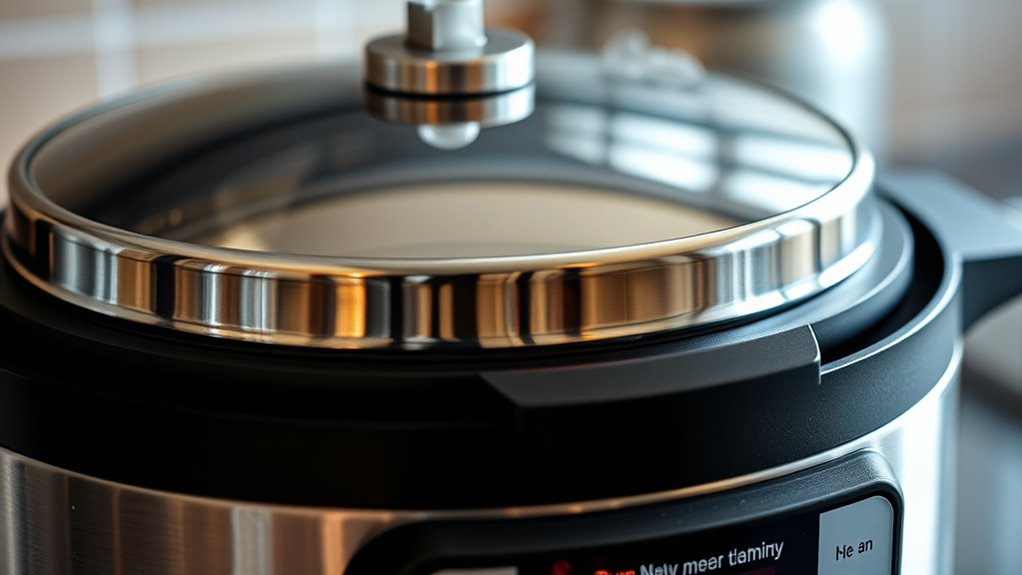
The burn message on your pressure cooker typically appears when the appliance detects that food or liquids are sticking to the bottom and overheating. This usually happens when there isn’t enough liquid in the pot, causing the contents to dry out and burn. Thick, starchy ingredients like rice or beans can also stick and scorch if they aren’t stirred or rinsed properly beforehand. Using ingredients that have a high tendency to stick, or cooking at too high a temperature, can trigger this warning. Additionally, layering ingredients unevenly can cause hot spots that burn easily. Understanding these causes helps you prevent the burn message from appearing, ensuring your food cooks evenly and your appliance stays in good condition. Being aware of essential oils for preventing sticking may also help in choosing ingredients that are less likely to cause scorching. Proper layering techniques and adjusting cooking times can further reduce the risk of triggering the burn message. Incorporating pressure cooker maintenance practices can also help keep your appliance functioning properly and avoid false burn alerts. Regularly inspecting and cleaning the pressure release valve can prevent buildup that might contribute to uneven heating and burning issues.
Properly Selecting and Preparing Your Ingredients
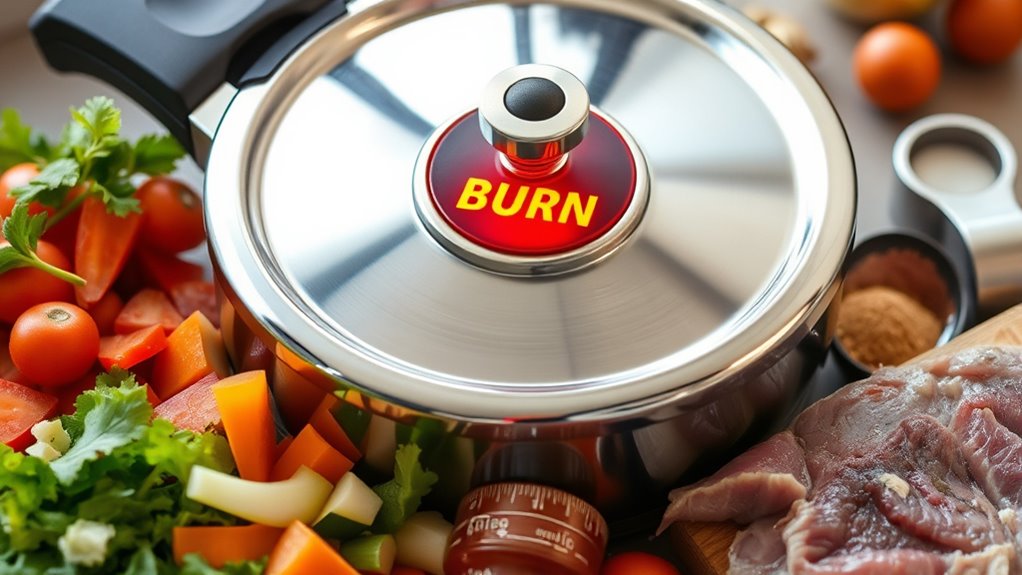
Choosing and preparing your ingredients carefully can substantially reduce the risk of triggering the burn message. Start by selecting ingredients that cook evenly and don’t release excessive foam or starch, which can stick to the bottom. Rinse vegetables and grains thoroughly to remove dirt and excess starch. Cut ingredients into uniform pieces to promote even cooking. Avoid adding thick sauces or purees that may stick or burn easily; instead, consider adding seasonings or liquids separately. Use fresh, high-quality ingredients to prevent uneven cooking or burning. Keep in mind that certain ingredients, like beans or tough cuts of meat, may require pre-cooking or soaking to reduce cooking time and prevent scorching. Properly prepared ingredients help ensure a safer, more efficient pressure cooking experience with fewer burn warnings. Additionally, understanding the automation of cooking processes in modern appliances can help you better anticipate and prevent common issues like burning. Recognizing the importance of consistent ingredient preparation can also contribute to more successful pressure cooking outcomes. Being aware of the types of ingredients that are more prone to causing burn messages can help you make informed choices before cooking. Being aware of how ingredient moisture content affects heat distribution can further improve your results.
Adjusting Your Liquid Levels for Safe Cooking

To prevent burn messages, you need to get your liquid levels just right. Make sure you’re using the proper measurements and keep an eye on the liquid during cooking. Remember, if you’re at a higher altitude, you might need to add a bit more liquid for safe and effective pressure cooking. Additionally, using a properly calibrated pressure cooker ensures accurate pressure and temperature control, reducing the risk of scorching. Being aware of pressure cooking safety guidelines can further help prevent overflows and burns. Monitoring your grocery savings techniques can also help you maintain your kitchen supplies without compromising safety. Proper portable camping gear maintenance can ensure your equipment functions safely and efficiently during cooking, especially when dealing with unexpected kitchen mishaps.
Proper Liquid Measurements
Have you ever wondered how much liquid you should add to your pressure cooker to guarantee safe and effective cooking? The key is to use enough liquid to create steam and build pressure but not so much that it overflows or dilutes your food. Generally, most pressure cookers require at least 1 to 1.5 cups of liquid, depending on the size and recipe. Always check your manufacturer’s guidelines, as some models need more or less. Avoid filling the cooker more than two-thirds full to prevent overflow. Remember, the right amount of liquid ensures proper pressure, prevents scorching, and keeps your food moist and flavorful. Measuring carefully before cooking helps you avoid burn messages and ensures safe, successful results every time. Additionally, understanding the liquid measurements necessary for your specific model can help you further prevent scorching and achieve optimal cooking outcomes. Knowing the pressure cooker capacity can also help you better gauge the appropriate liquid levels for different recipes. To further enhance your safety and results, always monitor pressure levels during cooking to avoid over-pressurization or undercooking. Incorporating proper liquid levels into your routine is essential for consistent and safe pressure cooking. Being aware of liquid consistency can also contribute to more predictable and reliable cooking results.
Monitoring During Cooking
Monitoring your pressure cooker during cooking is essential to guarantee the liquid level stays within a safe range. Regularly check the pressure indicator or safety valve to ensure the cooker maintains proper pressure. If your cooker has a transparent lid or a pressure gauge, keep an eye on these to see if the pressure remains steady. Avoid opening the lid prematurely or removing the pressure release valve, as sudden drops can cause scorching or burns. If you notice the liquid level dropping or steam escaping excessively, add a small amount of hot liquid carefully to prevent dry cooking. Staying attentive helps prevent overheating and scorching, ensuring your food cooks evenly and safely without triggering burn messages. Additionally, understanding how liquid levels impact the cooking process can help you better manage your pressure cooker and avoid common issues. Proper liquid management is crucial for avoiding burn alerts and ensuring optimal cooking results. Remember, consistent monitoring and adjusting during cooking are key to preventing scorching and ensuring a safe, successful pressure cooking experience. Regularly inspecting the safety features of your pressure cooker can also contribute to safe operation and help prevent accidental malfunctions.
Adjusting for Altitude
When cooking at higher altitudes, you need to modify your liquid levels to guarantee proper pressure buildup and prevent burn messages. As elevation increases, the air pressure decreases, meaning your pressure cooker needs more liquid to reach the desired pressure. If you don’t add enough, food can scorch or the cooker may give a burn warning. To compensate, add an extra 1-2 ounces of liquid for every 1,000 feet above sea level. Visualize your cooking process with these points:
- A bubbling stew with steam escaping steadily
- A sealed lid with a gentle jiggle or rocking
- A steady hiss as pressure builds
- A cooker that maintains pressure without dry spots
Adjusting your liquid ensures safe, efficient cooking at higher altitudes, preventing scorching and burn messages.
Choosing the Right Cooking Settings and Times
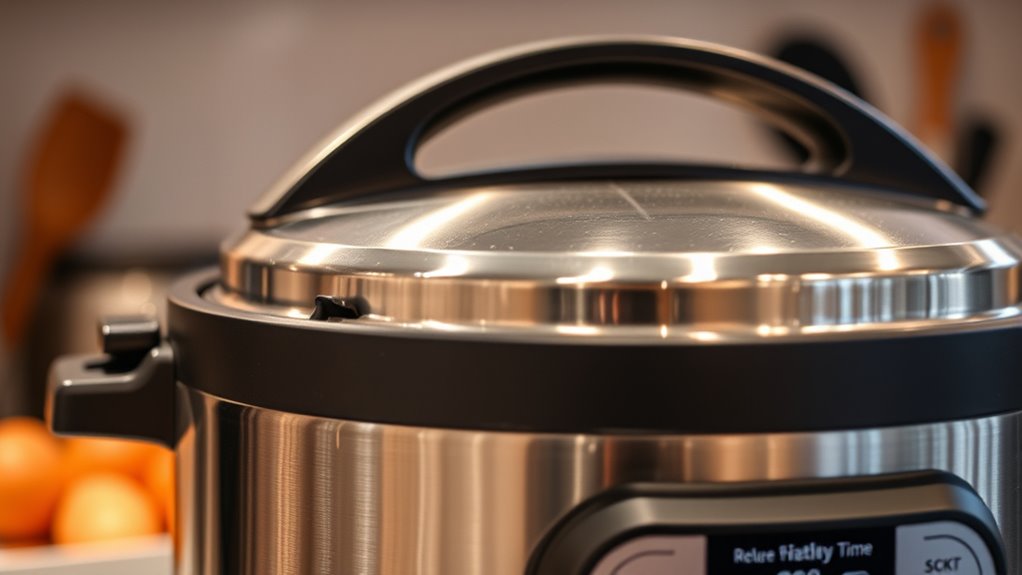
To prevent burn messages, you need to select the right pressure level for your recipe. Setting the correct cooking time guarantees your food cooks properly without overdoing it. Also, choosing the proper release method helps avoid excess pressure and keeps your cooker safe.
Adjust Pressure Level Appropriately
Choosing the right pressure level on your pressure cooker is essential for safe and effective cooking. High pressure cooks food faster but increases the risk of scorching if not managed properly. To adjust pressure appropriately, consider the type of food and recipe requirements. Lower pressure settings are ideal for delicate dishes like fish or vegetables, preventing overcooking. Higher pressure works well for tougher ingredients like beans or stews, speeding up the process without scorching.
Think about these factors:
- Ingredient sensitivity to heat
- Recommended cooking pressure in recipes
- Soil and moisture content of ingredients
- The need to prevent burning or sticking
Set Correct Cooking Duration
Setting the correct cooking duration is key to guaranteeing your food turns out perfectly without overcooking or burning. Always refer to your recipe or pressure cooker manual for recommended times, as different ingredients need different settings. Use the built-in timer or an external one to monitor cooking precisely. If you’re adapting a recipe, start with the lower end of the suggested time and add more if needed. Keep in mind that overcooking can lead to burning, especially with delicate ingredients like vegetables or seafood. Adjust times based on your altitude and pressure level, as these can affect cooking speed. Proper timing helps prevent scorching and ensures your meal is cooked thoroughly, saving you from the frustration of burnt food and pressure cooker messes.
Use Proper Release Method
Selecting the appropriate release method is essential for ensuring your pressure cooker operates safely and effectively. Depending on what you’re cooking, you should choose between natural release, quick release, or a combination of both. Using the right method prevents excess steam buildup and minimizes the risk of scorching or messes.
- Natural release allows pressure to decrease gradually, perfect for tender meats and grains
- Quick release rapidly releases steam, ideal for vegetables or delicate foods
- Combining methods helps manage stubborn or thick sauces
- Always follow your recipe’s guidance for release timing to avoid overcooking or scorching
Layering Ingredients to Prevent Direct Contact With Heat
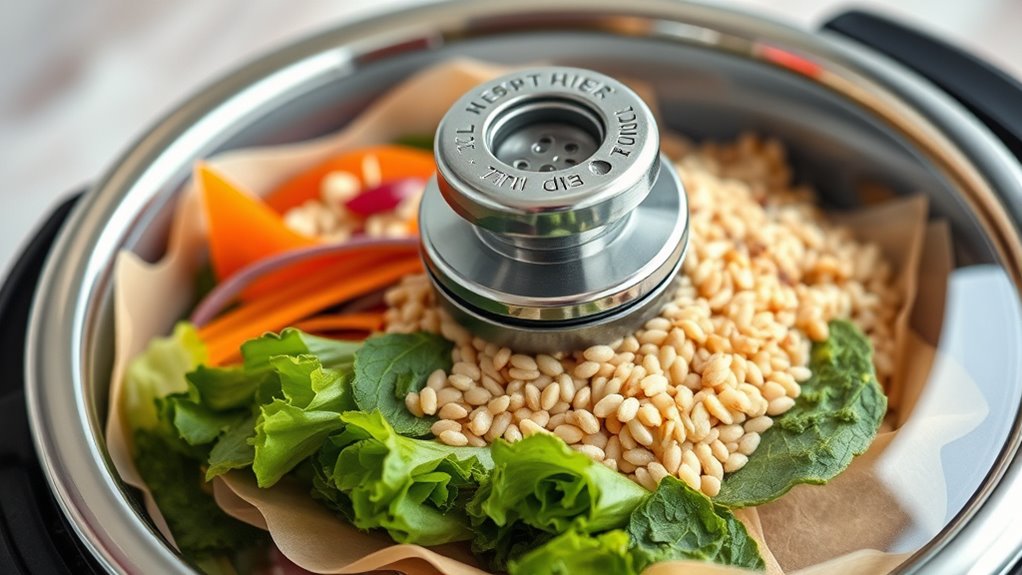
To prevent the burn message and guarantee even cooking, you should layer ingredients carefully so they don’t come into direct contact with the heat source. Place sturdy ingredients like root vegetables or meats at the bottom to create a barrier. Layer more delicate items, such as seafood or grains, on top, avoiding direct contact with the heating element. Using a trivet or steaming rack can help elevate ingredients and prevent scorching. Here’s a simple way to visualize layering:
| Layer Type | Placement |
|---|---|
| Hard vegetables/meats | Bottom of the pressure cooker |
| Trivet or rack | Between heat source and ingredients |
| Delicate ingredients | Above the trivet or rack |
| Liquids (broth, water) | Covering ingredients lightly |
| Final layer | A thin layer of sauce or oil |
This approach reduces scorching and promotes even cooking.
Maintaining and Cleaning Your Pressure Cooker
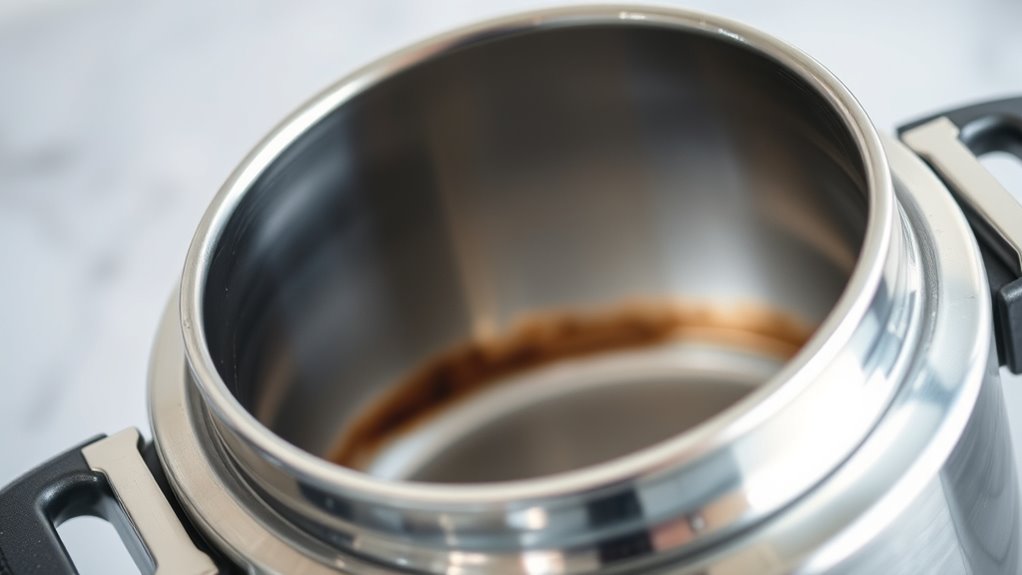
Regular maintenance and thorough cleaning are essential to keep your pressure cooker functioning safely and efficiently. Proper upkeep prevents buildup that can cause scorching or burn messages. After each use, wash the lid, gasket, and pot with warm, soapy water. Check the sealing ring for cracks or damage and replace if needed. Remove and clean the pressure vent and valve to ensure proper steam release. Regularly inspect the bottom for food residue or burnt-on spots that could impair heat distribution. For stubborn stains, soak parts in vinegar or use a gentle scrubber. Keep the exterior clean and dry to prevent corrosion. Remember, a well-maintained pressure cooker not only lasts longer but also cooks safely and evenly.
Using Thickeners and Sauces Correctly
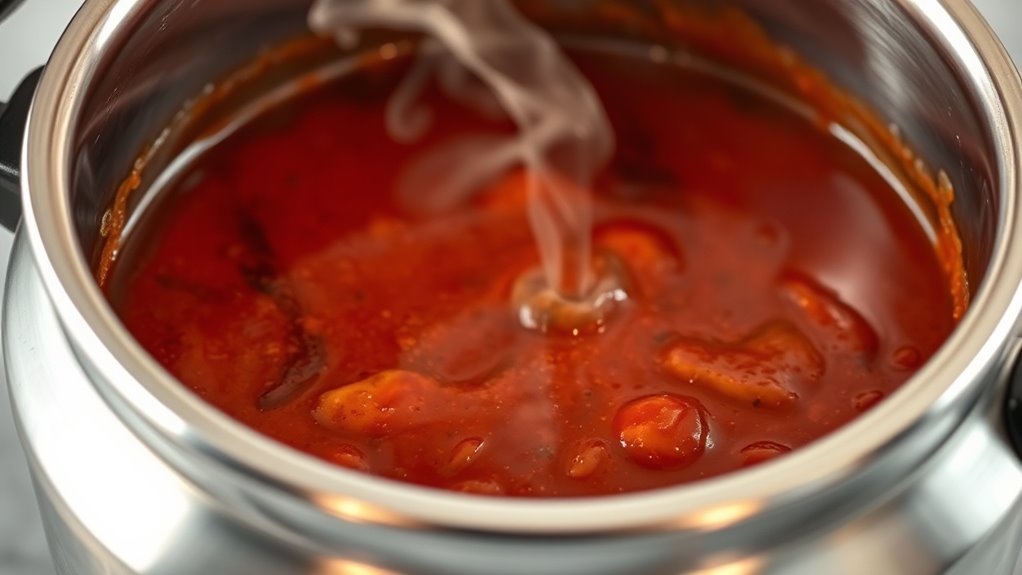
Using thickeners and sauces properly guarantees your dishes turn out smooth and flavorful without triggering burn messages or straining your pressure cooker. To prevent scorching, add thickeners like cornstarch or flour toward the end of cooking, ideally after releasing pressure or during the natural release phase. Use liquids with high heat tolerance, and avoid thickening agents that settle at the bottom. Here’s a quick comparison:
| Thickener | Best Usage |
|---|---|
| Cornstarch | Mix with cold water, add near end, stir well |
| Flour | Combine with fat, cook briefly before sealing |
| Arrowroot | Use in acidic sauces, add late in cooking |
| Tapioca | For long cooking, add early or midway |
| Gelatin | For desserts, add after cooking is complete |
Choosing the right thickener and timing ensures your sauces stay smooth and prevent scorching.
Troubleshooting Common Issues During Cooking
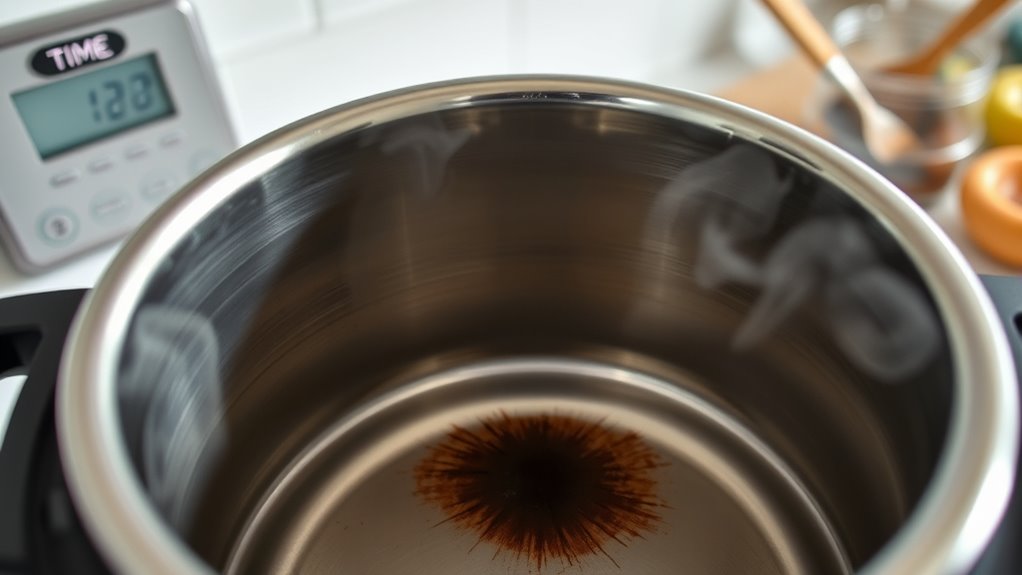
Even when you follow all the steps for thickening and adding sauces correctly, issues can still arise during pressure cooking. Common problems include food burning, undercooked ingredients, uneven heat distribution, and pressure not building properly. To troubleshoot, check the following:
- Ensure enough liquid is in the cooker to prevent burning and help generate steam.
- Verify the sealing ring is properly positioned and intact for consistent pressure.
- Adjust the heat setting if the cooker is overheating or not reaching pressure.
- Stir ingredients occasionally if the recipe allows, to prevent sticking and burning at the bottom.
Being attentive to these factors helps you avoid scorch messages and guarantees smooth, safe pressure cooking every time.
Tips for Safe and Efficient Pressure Cooking
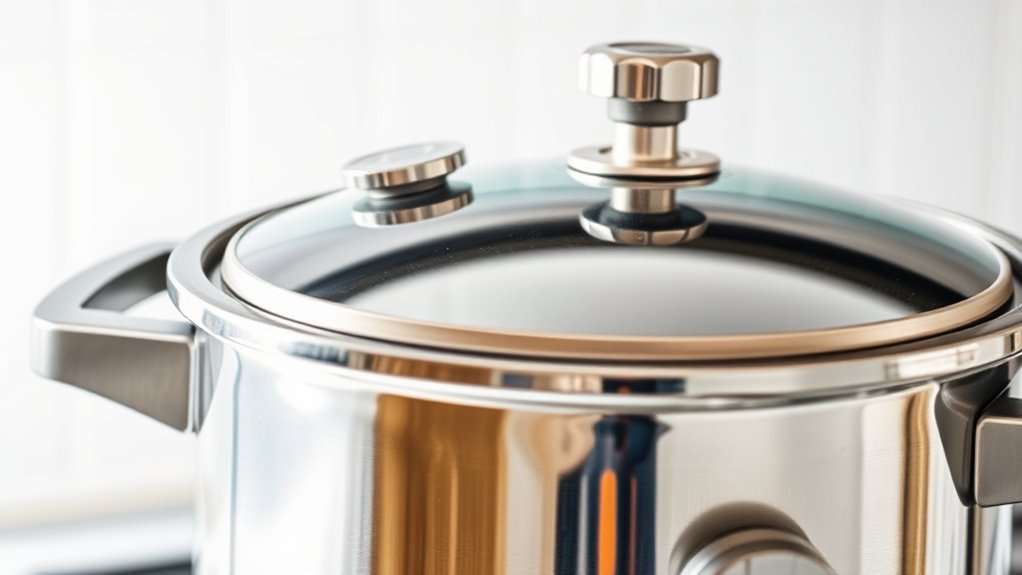
To guarantee safe and efficient pressure cooking, start by carefully reading your appliance’s manual and following all manufacturer guidelines. Always inspect the sealing ring and safety valves before use to verify proper functioning. Use the recommended amount of liquid—typically at least one cup—to generate enough steam and prevent burning. Avoid overcrowding the cooker, which can block steam release and cause scorching. Adjust heat to maintain steady pressure without excessive fluctuations, and do not force the lid open after cooking. Keep your cooker clean, especially around the valves and gasket, to prevent buildup that could interfere with pressure regulation. Following these tips helps prevent burn messages, ensures even cooking, and keeps your appliance operating safely.
Frequently Asked Questions
How Can I Tell if My Pressure Cooker Is Damaged or Malfunctioning?
You can tell if your pressure cooker is damaged or malfunctioning by checking for leaks, unusual noises, or if the lid doesn’t seal properly. If it doesn’t reach pressure or releases steam excessively, that’s a red flag. Also, inspect the gasket and valves for cracks or wear. If you notice these issues, stop using it and have it tested or replaced to ensure safe cooking.
Are There Specific Ingredients That Are More Prone to Causing a Burn Message?
Certain ingredients, like thick sauces, pastes, or foods with low moisture content, are more prone to causing a burn message. When you cook dishes with little liquid, the cooker’s sensor detects potential scorching and triggers the warning. To prevent this, always add enough liquid, stir ingredients well, and avoid layering thick sauces directly on the bottom. Using a natural release method also helps reduce the risk.
Can Adjusting the Pressure Level Reduce the Chances of Scorching?
Yes, adjusting the pressure level can help prevent scorching, especially if you keep an eye on the heat. Think of it as walking a tightrope—you want just enough pressure to cook thoroughly without overdoing it. Lowering the pressure allows ingredients to cook more gently, reducing the risk of burning and the dreaded burn message. Experiment with different settings to find the sweet spot that keeps your food safe and tasty.
What Signs Indicate My Pressure Cooker Needs Repair or Replacement?
If your pressure cooker isn’t sealing properly, making strange noises, or if steam leaks constantly, it’s time to repair or replace it. Also, persistent difficulty reaching or maintaining pressure, foul odors, or corrosion signals issues that can’t be fixed easily. You should stop using it immediately if safety features fail or if parts like the gasket are damaged. Prioritize safety to prevent accidents or injuries.
How Do Altitude Changes Affect Pressure Cooker Safety and Burn Risk?
Altitude changes are like a ripple in your cooking journey, directly affecting your pressure cooker’s safety and burn risk. When you cook at higher altitudes, the reduced atmospheric pressure means you need to adjust the pressure settings and cooking time. Failing to do so can lead to under or over-pressurization, increasing the chance of scorching or a burn message. Always consult your cooker’s manual for altitude-specific adjustments to stay safe and prevent burns.
Conclusion
By understanding how to prevent scorching and properly care for your pressure cooker, you’ll keep the burn message at bay like a trusty shield. Always select ingredients carefully, monitor your liquid levels, and layer your foods thoughtfully. With these tips, cooking becomes a smooth sail rather than a turbulent storm. Think of your pressure cooker as a well-trained partner—when cared for and used correctly, it’ll serve up delicious meals without a hitch every time.


